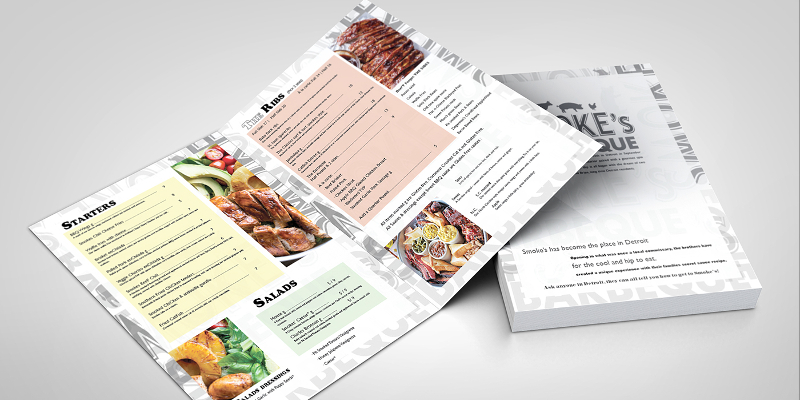12+ Barbecue Menu Examples to Download
What do you want for lunch? Where will we eat our lunch today? These are among the hardest questions asked in our lives. We spend so much time contemplating on what to eat. The worse part is, when you have already decided on something to eat, the food is unavailable at the moment so you have to start thinking again about what to replace on your cravings.
To help us decide on what to eat and to excite our taste buds, menus are created by restaurants. Menus serve multiple roles in a restaurant: they serve as a guide for customers on what to eat; they introduce new food served; they showcase and advertise the different food and styles in a restaurant menu; they promote the name and branding of the store, and they are the representative on what a certain restaurant can offer.
Similarly, restaurants and stores offering barbecue products are in need of menu for their customers. Just like a typical menu, a barbecue menu offers different barbecue styles and sometimes with promos, freebies, and packages. A modern menu helps the customer on what to pick in their cravings for barbecue and helps them decide on which is appealing visually and which looks tasty.
In this article, we are providing barbecue menu examples so you can decide on what designs to include in your menu. Additionally, apart from barbecue menu, to help you in organizing and designing your menu as a whole, the next sections provide tips and points on how can you be effective in your menu. You may also see the lunch menu designs.
Barbecue Menu Examples
Here are a variety of barbecue menu examples to choose from. But take note that your menu should reflect on the characteristics of your company and what you want people to expect from you. So choose wisely or you yourself can design and customize your menu as well.
Black Barbecue Menu
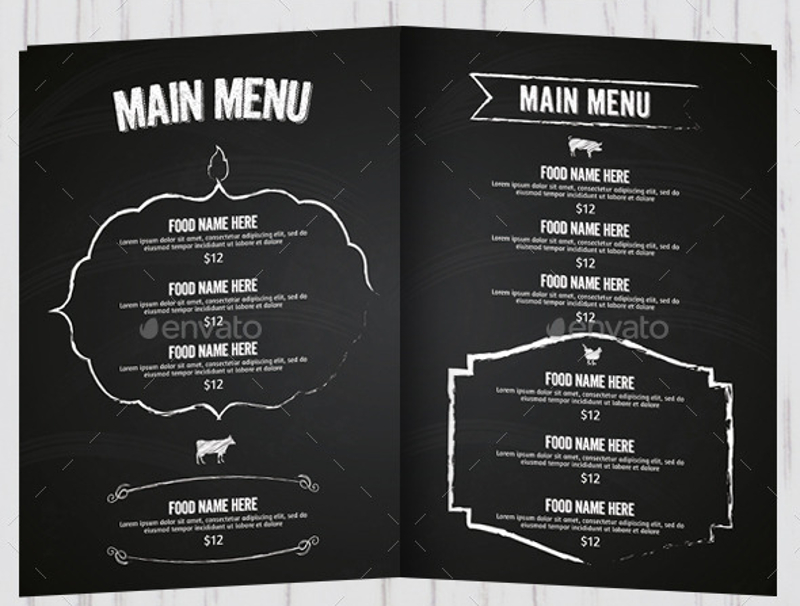
Barbecue Steak Menu
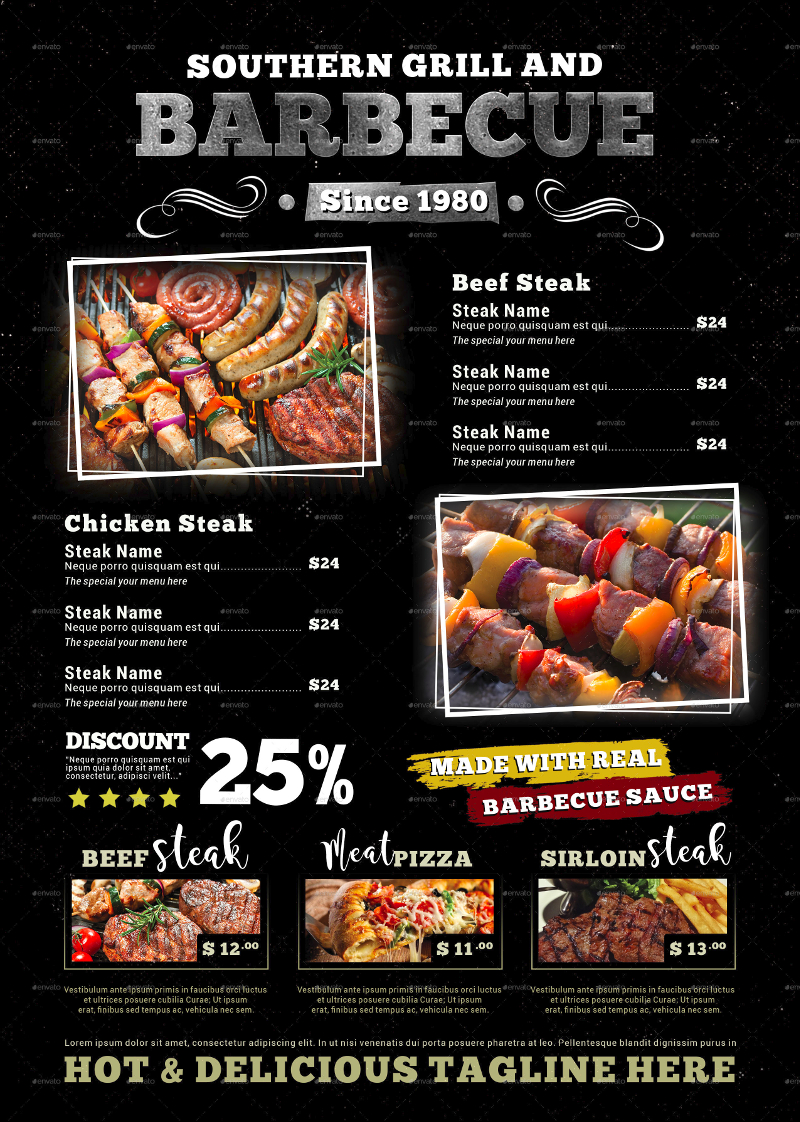
Grill Barbecue Restaurant Menu
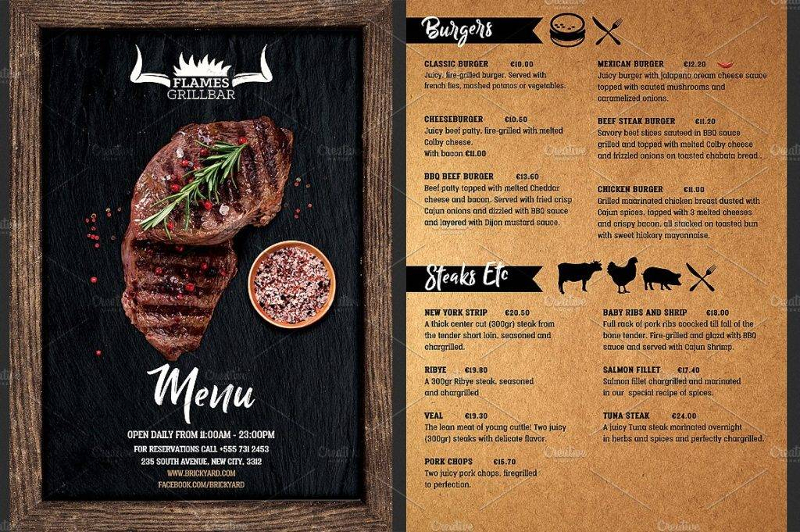
BBQ Steak Menu
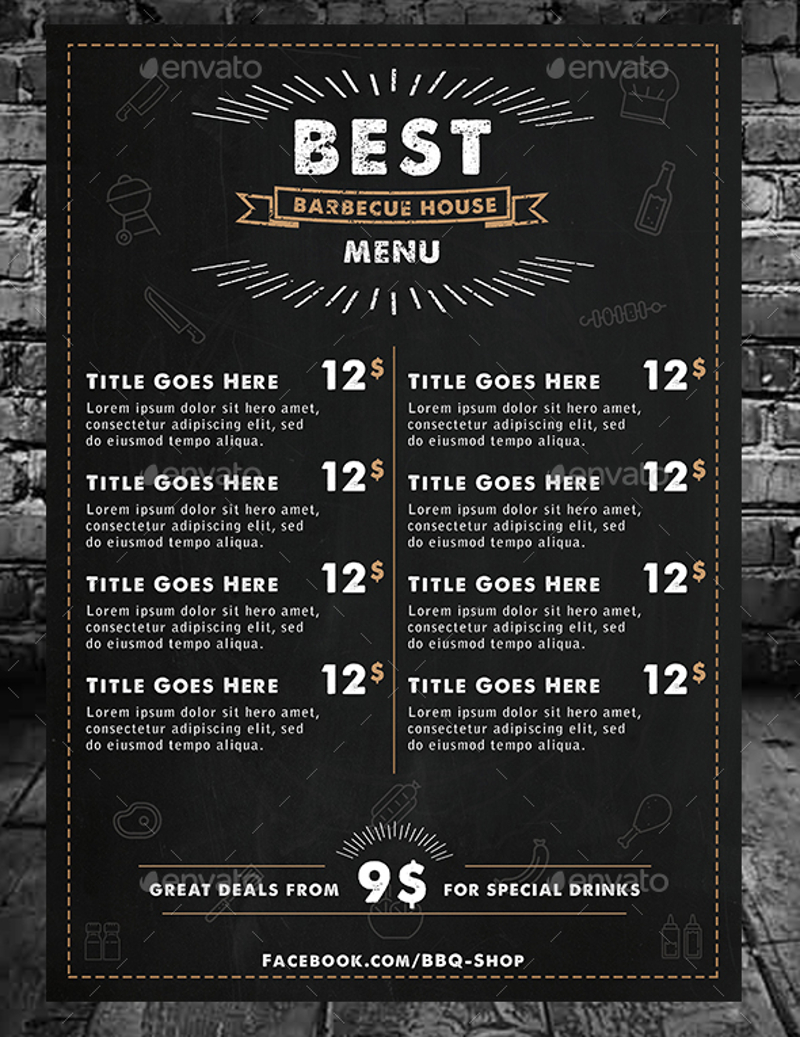
BBQ Tri-Fold Menu
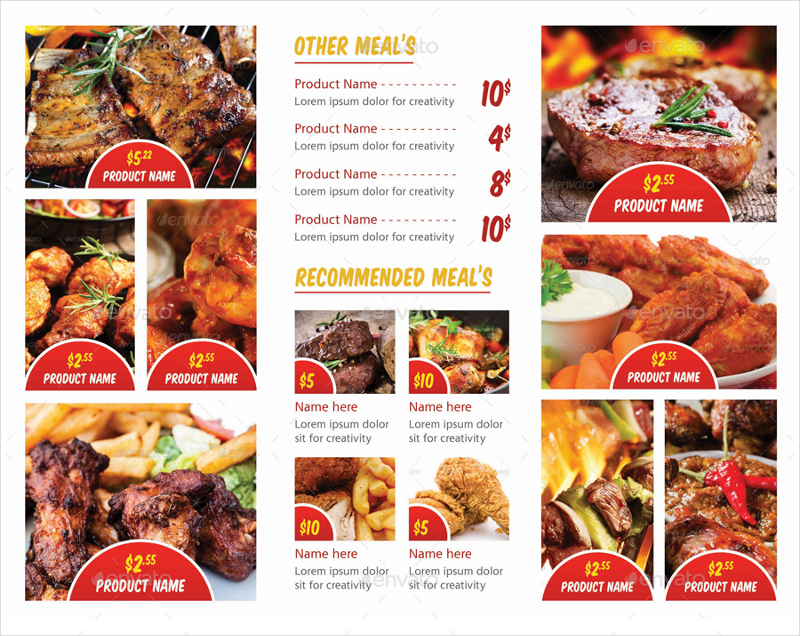
Editable BBQ Menu Sign
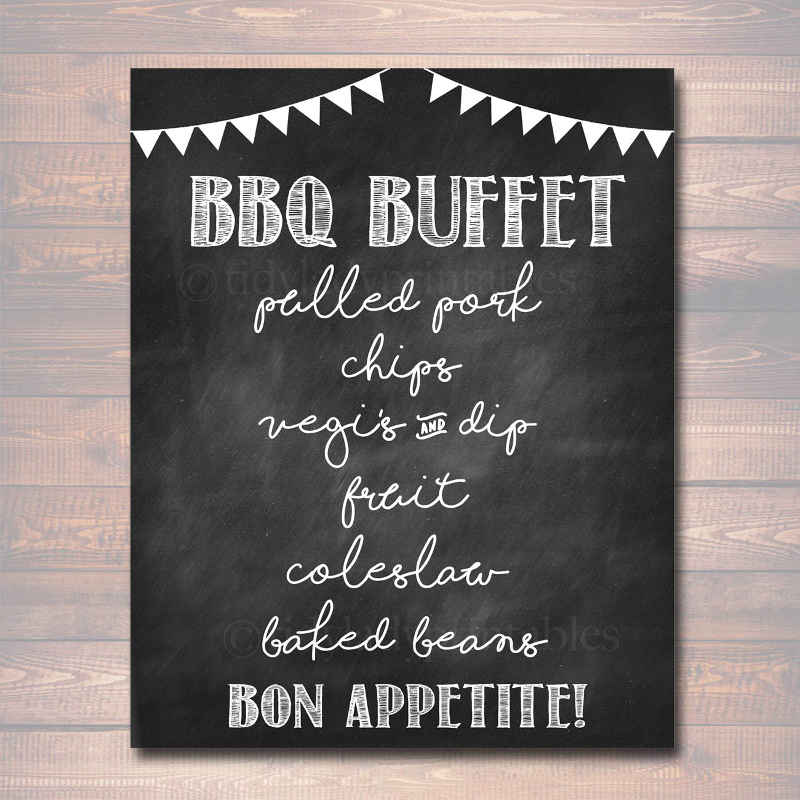
Barbecue Restaurant Menu

Modern Restaurant Menu
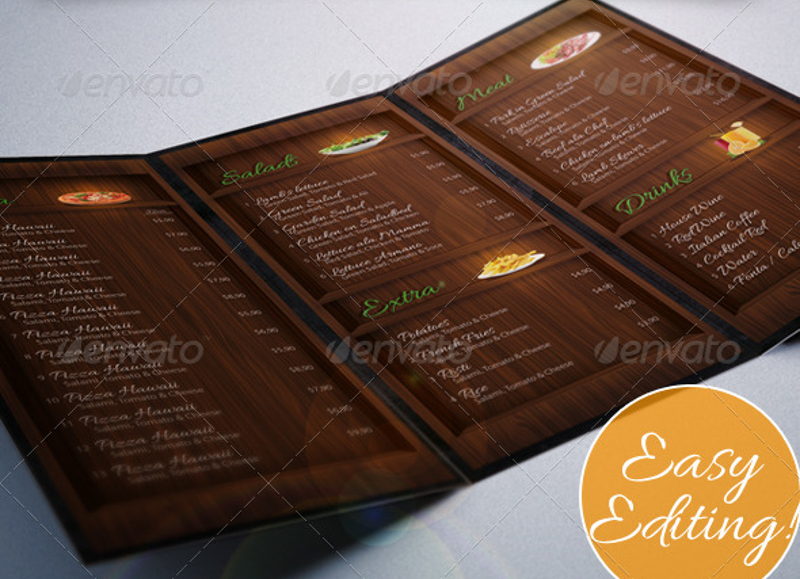
Classic BBQ Menu
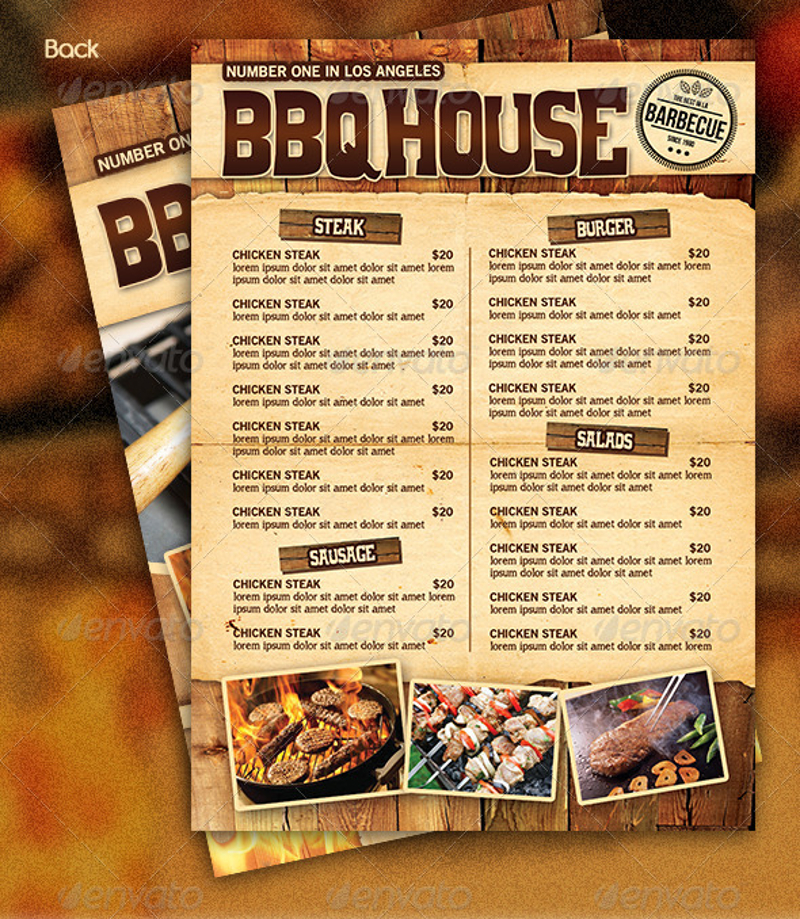
Big Barbecue Set Menu

Vintage BBQ Menu
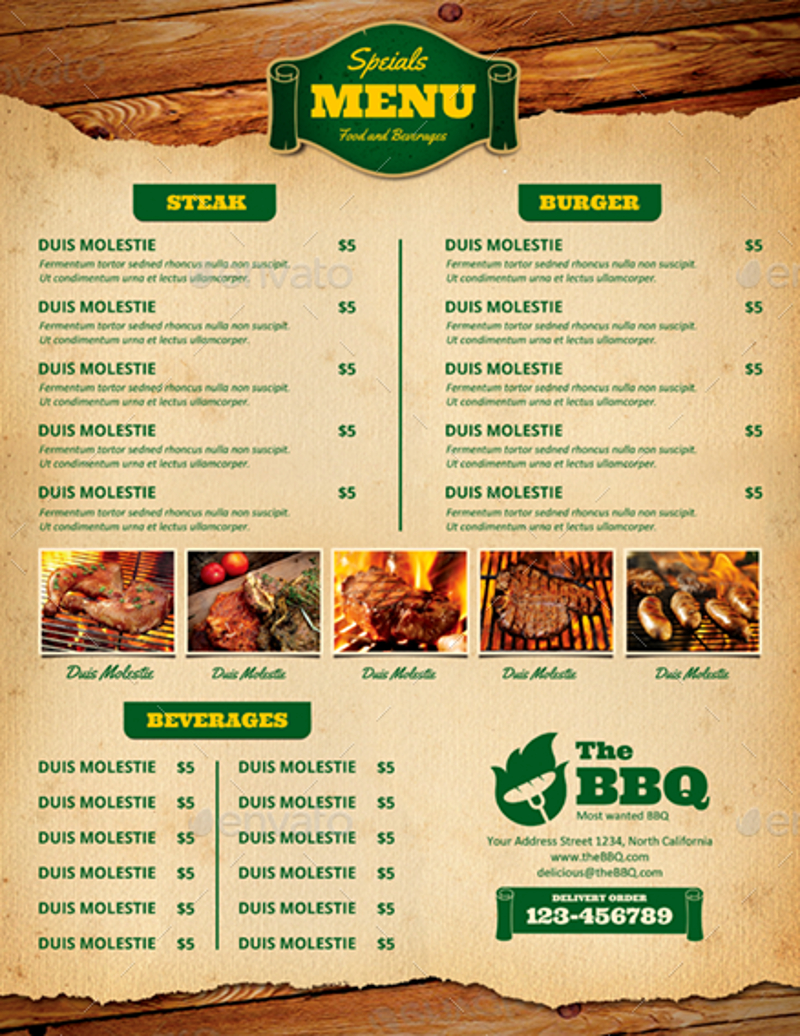
Tri-Fold BBQ Steak Menu

BBQ House Menu Sample
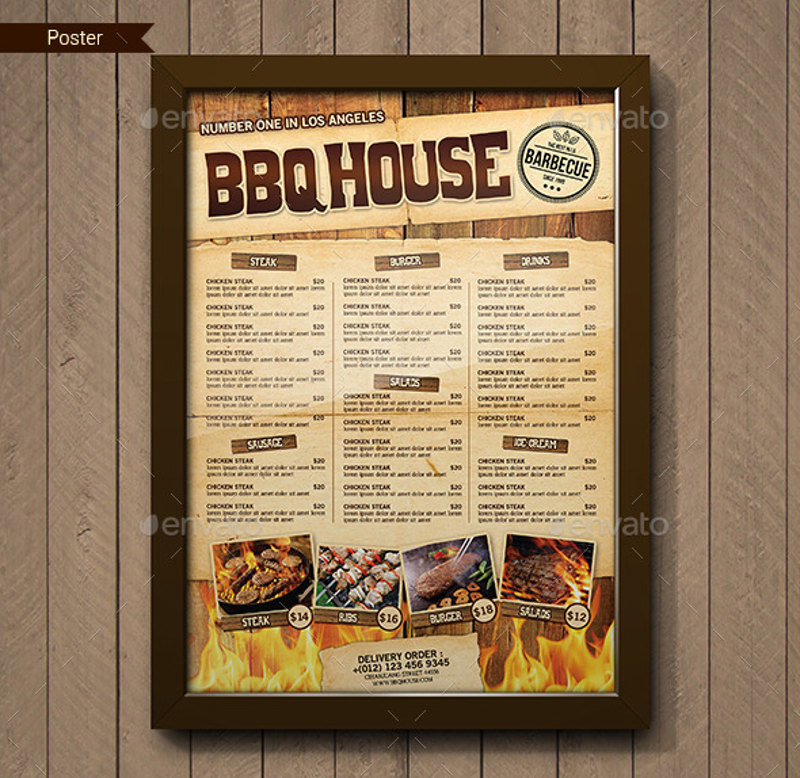
Types of Grills
In having a barbecue restaurant, you have to know the different types of grills that are commonly used so you will know what is the perfect type of grill to be used for a certain meat, for a certain event or occasion in a certain venue that fits your lifestyle and personal budget. Here are the four common types of a grill that you must take note.
1. Gas Grills
Grass grills are said to be the most popular type of grill that is run on bottled propane or natural gas. These are perfectly designed for impatient chefs who want to quickly cook their food or those that are in the rush of cooking their barbecue. The grilling surface may be made of porcelain-covered steel bars, bent stainless steel sheets, iron gates, or stainless steel bars. You may also see the bar menu.
2. Charcoal Grills
This type of grill is run on charcoal briquettes. This is perfect for people who want the taste of barbecue that is cooked with charcoal and is patient enough to wait until the charcoal got to heat up as cooking with charcoal is usually more time-consuming than a gas grill. There is no better experience than to have a taste of the real barbecue, which most prefer, for this can satisfy your craving for that smoky grilled barbecue. But after cooking, you need to clean up the grill and dispose of the ashes properly. Also, another disadvantage is that charcoal is more expensive compared to gas. You may also see the coffee menu examples.
3. Electric Grills
No fire is required for this type of grill. Instead, an electricity is required to heat up the grill plates. This is used best in cities where you are prohibited to use gas and charcoal grills for safety purposes. However, although electric grills can produce an output which is very similar to traditional grills, it cannot replace the smoky flavor produced by using the traditional method of grilling.
4. Portable Grills
The unique characteristic of this grill that makes it distinct from other types of a grill is that it is very handy and portable—can easily be transported from one place to another. Also, this type of grill can run on propane or charcoal. This grill is perfect for outdoor activities such as camping and picnics, but you can only cook for a limited amount of meat since this is usually small.
How to Organize and Design your Menu
The tips included here are not only for barbecue menu in particular but as a menu in general. In order to understand that organizing and designing your menu is important, you need to read the following so you have a better grip and comparison on what others do with their menus and what are the usual trend in the organization and designing of a sample menu.
Sequence
Your menu should be organized in a way that the menu categories are listed in the sequence that they are eaten. Although not every restaurant has a similar sequence, here is a sequence commonly followed by them, especially French, which is believed to be the proper sequence for eating a full-course meal.
- Appetizer. Appetizers, as the word suggests, are food that stimulates your taste buds in preparation for a meal. These also keep the hungry people fed until the main dish is served. Examples of appetizers are potato salad, tomato salad, prawns or shrimps with lettuce, fruit frappe, and smoked salmon.
- Potage or soup. Soup or potage, a thick soup, also acts as an appetizer. Take note that clear soup is served first before the thick soup. Clear soups include onion soup, soup with strips of root vegetables, and soup with strips of pancakes. Thick soups include lobster-flavored soup and cream of green beans. You may also see the menu card samples.
- Egg dishes. Next to be served are the egg dishes. Examples of egg dishes are as follows: classic omelet, tomato omelet, mushroom omelet, scrambled egg, and hard-boiled egg.
- Pasta or rice. There are different varieties of pasta. The determining factor for the name of the pasta is its size, shape, and color. Examples of pasta are anelloni, barbine, bavette, bavettine, bigoli, boccoli, bucatini, busiati, cacavelle, calamarata, calamaretti, campanelle, capellini, capunti, casarecce, castellane, cavatappi, cavatelli, cencioni, chiferri, ciriole, conchiglie, corzetti, crezte di gali, ditalini, elicoidali, fagioloni, farfalle, fazzoletti, fedelini, fettucce, fileja, fiorentine, fiori, foglie d’ulivo, fusilli, garganelli, gemelli, gnocchi, gomiti, gramigne, lagane, lanterne, lasagna, lasagnette, lasagnotte, linguettine, linguine, lumache, maccheroni, macheroncelli, mafalde, mafaldine, malloreddus, mandala, manicotti, marille, marziani, matriciani, mezzani, mezze penne, mezzi bombardoni, orecchiette, paccheri, pappardelle, pasta el ceppo, penne, pennoni, perciatelli, pici, pillus, pipe rigate, pizzocherri, quadrefiore, radiatori, ricciolini, ricciutelle, rigatoni, rigatoncini, rombi, rotelle, rotini, sagnarelli, sagnette, sagne ‘ncannulate, sedani, sorprese, spaghetti, spaghettini, spaghettoni, spirali, spiralini, stringozzi, tagliatelle, taglierini, testaroli, trenette, trenne, torchio, tripoline, tuffoli, vermicelli, vermicelloni, ziti, zitoni, etc. You may also see the printable menu designs.
- Fish dishes. Fish dishes are a good starter and preparation for the heavier meats as fish meat has soft fibers compared to the other types of meat. Examples of fish dishes as-as follows: fish fillets in which the fish is coated with flour, egg, and breadcrumb and deep fried, fish fried in butter, fish fillet with mushroom puree dressings and coated with a cheese sauce, fish grilled with egg- and butter-based sauce flavored with tarragon, and lobster with thickened sauce flavored with brandy and finished with butter.
- Entree. These are small garnished dishes which are almost always accompanied by very rich gravy or sauce and may or may not be served with potatoes and vegetables depending on when relieve will follow entree. Examples of entree are sauteed chicken with tomatoes and mushroom, breast and wing of a chicken, fried minute steak and flavored with onions and mushrooms, and grilled double fillet steak. You may also see the dinner menu.
- Sorbet. This is considered as the rest of courses as it counteracts the previous dishes and starts stimulating and appetizing again the taste buds for the other course to follow. Sorbet is a dessert made with sweetened water flavor with different flavorings. It is usually confused with water ice and often mistaken as a sherbet. Because this has an alcohol content, the freezing temperature is lower than that of water alone and is the reason for its softer texture. Examples of sorbet are lemon sorbet, champagne sorbet, calvados sorbet, and peach sorbet.
- Releve. This is considered to be the main meat dish served with potatoes and green vegetables in a sauce or roast gravy. This dish may contain chicken, beef, fowl, ham, tongue, and pork. Examples of releve are boned and roasted beef sirloin, roast leg of pork, and roast leg of lamb.
- Roast. This stage, of course, is the start of the gradual regression from heavy back to the lighter dish. The different types of roasts have its own sauce and gravy. Usually, the roasted animals come from the poultry. Examples are duck, chicken, turkey, quail, and pheasant.
- Legumes or vegetables. Next are legumes and vegetables with sauce. These are dishes that can be served as is or included in other dishes such as entree, releve, and roast dishes. Examples of legumes and vegetables are grilled mushroom, cauliflower, and beans tossed in butter.
- Salad. A salad is a mixture of small pieces of food, usually vegetables and are served at room temperature or chilled. Its base is made of usually lettuce, arugula, kale, or spinach. This is best served with dressing as salad alone can be boring while dressing can enhance its taste. Examples of salad menu include a green salad which is composed of lettuce, spinach, and arugula, a vegetable salad which is composed mostly of non-green vegetables, wedge salad which is made from the head of lettuce, and bound salads such as tuna salad, pasta salad, chicken salad, egg salad, and potato salad. As salads are best served with dressings, dressings include blue cheese dressing, French dressing, ginger dressing, honey mustard, Italian dressing, thousand island dressing, and wafu dressing.
- Cold buffet. During this course, served are small chilled meat cut into pieces. Examples of cold buffet dishes are a roast duck, lobster mayonnaise, and roast chicken. The dish in this course is designed to gradually lower the hype of eating large food. So, in this course, the items usually come in small sizes.
- Sweets or desserts. This is the start of the conclusion of a meal, although not necessarily the end of a meal. The term “desserts” is used interchangeably with “sweets” since most of the desserts come in sweet taste. It includes confections such as cakes, cookies, biscuits, gelatins, pastries, tarts, ice cream, pies, puddings, and custards. The usual ingredient that is commonly present in most, if not all, of the desserts are cane sugar, palm sugar, various types of syrups such as maple syrup, molasses, or corn syrup, flour or other starches, butter or lard, eggs, salt, and other flavorings such as chocolate, peanut butter, fruits, and nuts.
- Savory. Next in line is the savory dish which acts as a dish to clear the palate before serving the dish in the next course. Typical savories include Scotch woodcock, Welsh rarebit, sardines on toast, angels on horseback, and devils on horseback.
- Cheese. This can be an alternative course to the savory dish. Cheese or fromage is usually served with butter, crackers, and celery. Cheese may be soft, semi-soft, firm, and blue-veined. Sub-categories for these major categories of cheese include Roquefort, camembert, cotija, chèvre, feta, mozzarella, emmental, cheddar, gouda, taleggio, parmesan, and manchego.
- Beverage. Although this is not counted as a course, this is served as a conclusion to the full-course meal. Different types of a beverage can be served as a drink whether it may be hot or cold or alcoholic or non-alcoholic. Non-alcoholic drinks include water, milk, tea, coffee, carbonated drinks made from cola, orange, various roots, ginger, or lemon, and juice and juice drinks which come from fruits such as pineapple, apple, grape, lime, and lemon. On the other hand, alcoholic drinks include beer, cider, wine, and spirits. You may also see finest wine menu designs.
Design
By now, you must well aware of the importance of a menu in your restaurant and how your design can affect your customers and your store as well. In designing your menu, there are things that you must consider and there are also things that you must never forget to include as these are considered vital in one’s menu. This last section of this article will give you tips for the designing of your menu. You may not have to bear one by one in mind but you have to grip the idea on the designing as a whole. You might as well apply them or make a checklist if you have already done those things. So here are the vital things you need to consider in your menu.
- Content. Of course, the content of your menu is the focal point and highlight of your menu. And the above tips for the sequence of food is discussed above. You may consider them as you arrange your dishes in your menu. Also, remember to check and double check for the completeness of your dishes as you might have forgotten some of the dishes that you are offering. Not only that, check for typographical and grammatical errors as you go through each dish. This simple mistake can have a lot of impacts especially to customers who are very particular in grammar and spelling. Errors can also lessen the credibility of your restaurant or store so you better keep an eye on them. Make sure that you do multiple proofreads before sending them out for final printing. Otherwise, it will cost you a lot in reprinting copies whenever you found errors in the first printings. It is better to spend more hours in checking than more money in reprinting. You may also see drink menu.
- Size. Next thing you need to consider is the size of our menu. The size should be big enough for the dishes to stay visually appealing but not too big as you need to spend more in printing for large-sized papers. This reminds us that whenever you are making a decision, you should always weigh the cost versus the benefits that you can get out of it. On the other hand, your menu should not be too small that it will cause overcrowding of the words and photos but small enough to fit all of the important contents including the graphics.
- Photos. It is better that you include photos which are the actual photo of the dish that you are serving so that people will not give too much expectation of your dish. Otherwise, they will expect too much of your meal and might end up getting disappointed if you are serving them a dish with a presentation that is totally different from what you displayed in your menu. But, that does not mean that you will not enhance your photo. Instead, you have to make sure that the images you are including in your menu has a good quality and is the perfect representation of your food menu.
- Pricing. There are many ways to price your product. One is to have similar or almost the same pricing as your competitor restaurants. Checking the prices of the competitors is important so you can have a basis for your own pricing. But, make sure that you understand the nature of your business well as well as your competitors’ so you perfectly understand how did they come up with their pricing. Another method in determining your price is to compute the cost for your direct materials, direct labor, and overhead and add a certain percentage. This is the basic way of accounting on how to price your product. Lastly, you can also use the factory method in which you will mark up every item on the menu by the same amount. For example, you will multiply the raw food cost by the pricing factor. You may also see typography menu examples.
- Font. In choosing a font style, font size, and font color for your menu, you must also consider the graphics around the text as well as the background color or image. The font must be complementary to these and must somehow have a relationship with them. For example, your background color or image must not overlap your text, making it hard to read or not readable at all. Be sure you have an eye to spot these things.
- Color. Do you believe that there are colors that can trigger your appetite? Researchers say that there are colors that can stimulate your craving for food. Applying to your menu, the overall color of your menu must be appealing to the eye of the customers and must provoke their hunger. These colors are red, orange, and yellow. Note these colors and apply them to your menu. Who knows it might actually work! You may also see chalkboard menu designs.


